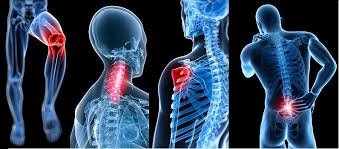Our therapists may use a combination of techniques during a Therapeutic Massage session such as Deep Tissue Massage, Myofascial Release, Sports Massage, Neuromuscular Therapy and Orthopedic Massage, depending on your specific needs and muscular issues. All of our services (except for Prenatal Massage and Massage Cupping) are under the heading of Therapeutic Massage on our scheduler, therefor there is no need to pick a particular style when booking your appointment.
To get a better understanding of what each technique involves, please read below:
Deep tissue massage
Deep Tissue Massage is a technique used to address injury or issues occurring in the deeper soft tissue and fascial layers of the body. Scarring, adhesions, and muscular spasm are all treated with various forms of Deep Tissue Massage, all with the goal of restoring normal function and motion to the areas affected. Deep tissue does not necessarily mean deep pressure, but rather a concentrated, specific manner of working in the deeper layers of the body to allow for more permanent changes to occur.
Because this technique is very specific, some discomfort may be experienced for up to 24-36 hours following a session. We recommend that the client drink plenty of water following a session to expedite the elimination of metabolic wastes from the blood stream and therefore speed recovery.
Sports Massage
From Iron Man triathletes to weekend warriors, more people are incorporating Sports Massage into their athletic routines. The focus of this technique is to improve circulation, flexibility and range of motion, decrease recovery time from training, prevent injury, and improve muscular efficiency which will result in better performance.
Our therapists work closely with you to determine if stretching or strengthening exercises will compliment your routine or help you to meet your performance goals, and give advice accordingly.
Sports Massage treatments are often used during training and before and after a particular event to prevent injury in improve performance and recovery.
Neuromuscular Therapy
Neuromuscular Therapy technique is used to restore balance to the nervous system and musculoskeletal systems. Injury, trauma, postural distortion or stress can influence nerve transmission and therefore overall function of the body. Based on symptoms and evaluation, our therapists may employ this technique to address what are called Trigger Points, or very specific areas of irritation, to restore balance and proper neurological function to the body.
Therapists properly trained in this technique use their palpation skills to detect these areas of irritation and constriction. Applying very specific pressure, the therapist is able to eliminate the irritation and restore normal nerve and muscular function. Studies have shown that most pain and discomfort in the body is caused by these Trigger Points located outside of the areas of sensation. For this reason, Neuromuscular and Trigger Point Therapy can be the answer for many people who have had longstanding pain that has otherwise been untreatable.
Myofascial Release
Myofascial Release technique addresses superficial to deep layers of connective tissue of the body known as fascia. This web of connective tissue surrounds and connects all of the muscles, organs, and other skeletal structures. Because of the interconnected nature of this tissue, restrictions in one area can eventually spread to other areas of the body, causing postural distortions that can lead to the occurrence of chronic pain patterns.
During the use of this technique, the fascia is directly manipulated with the goal of allowing the connective tissue fibers to reorganize and align themselves in a more flexible and functional manner. This technique will unwind deep holding patterns in the body, which will allow for greater movement and freedom in the body.
Orthopedic Massage
Orthopedic Massage incorporates a variety of techniques to treat various issues in the musculoskeletal system. Orthopedic Massage is not itself a technique, but rather a protocol of evaluation and treatment which is based on the principals of Orthopedic Medicine. This protocol includes the evaluation of injury using the same techniques utilized by orthopedic physicians, applying specific treatments based on evaluation results, and determining a course of treatment suited to the specific information gathered during the session and evaluation.
Knowledge of this type of treatment gives the therapist an edge in being able to properly assess an injury and therefore treat it as efficiently as possible, as well as refer to other practitioners if necessary.






